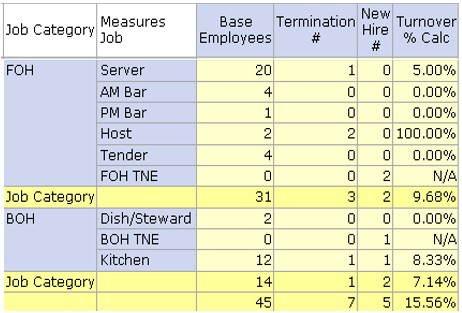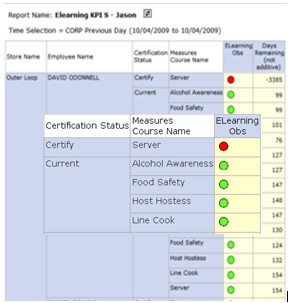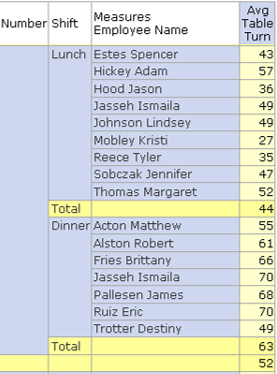
Today, for many restaurant companies, the challenge of harnessing the myriad of disparate data generated by the systems (POS, BOH, ERP, etc.) used to operate and manage their businesses is just that, a challenge. And when it comes to the Human Resource (HR) department, well, they're no different - the reason being, data associated with different tasks such as hiring, job satisfaction surveys, training details and performance management reviews all reside in different databases.
Having a solution that’s capable of helping you bring together data from any source and then transforming it so you can easily combine the data together to gain needed insights or get fact-based answers to questions is critical. Unless you can transform the data and make it compatible, there is no easy way to get answers to even the most basic questions. Today, most restaurant companies struggle to do this with operational or marketing data let alone HR, and the ones that do are doing it mostly through spreadsheets.
So, if HR could access the necessary data what should they look to accomplish first? Start with the elephant in the room. With hiring being one of the dominant pursuits of HR, one place to start is to look at one of the drivers behind this activity – turnover.
While attending an industry conference earlier this year I repeatedly heard that recruiting people to fill all the open positions was a big challenge. Many agreed this was only exacerbated by the high turnover rate which then feeds the time and high cost of training, etc. One company even noted that they experienced a 100-basis point difference in Comp Sales between stores with higher turnover versus lower turnover. And who couldn’t use an extra 1% in revenue these days?
While you’re never going to stop turnover, you’ll want to understand where it’s occurring and the drivers behind it if you’re going to have a chance to at least slow it down. Which, in turn, if successful, should have a positive impact on reducing hiring/training costs and improving sales. So, start by looking across the organization and over various time periods to see if there are any notable trends such as; are there any spikes in turnover, and if so, where and when did they occur?
Turnover Rates

From there, narrow the scope and look to see if there are specific locations/managers where turnover is consistently high. Once you have visibility into the areas where turnover is highest you can take additional steps to gain the insights needed to make changes. One option to consider: incorporate short/frequent employee surveys across the company or, at a minimum, implement them in the areas/locations where turnover is consistently above average. Regularly generating reports that utilize employee survey data can help spot trends and identify areas for improvement so action can be taken before it becomes a larger problem.
Training

HR should also include data related to training programs. Are employees receiving the training needed to perform the tasks they’re being assigned? Did they successfully complete the training and how well are they applying what they learned to their work? When are they due for their next training session? The importance of employee training and development in hospitality can’t be overstated because every job ultimately ties to your guests' satisfaction. Workers in every facet of hospitality, from dishwashers to managers, affect the guest experience. It’s important to begin training your new recruits as soon as possible, instructing them on your standard operating procedures. This training should aid in your ability to determine the individuals who might be shaped into future leaders. Further improvements can be made with targeted training efforts. For example, say your guest experience surveys are showing certain locations are receiving low marks for food quality and service. Focusing training efforts on these areas, at the locations involved, will help improve the guest experience.
Employee Performance


From there you can use the data to examine employee performance. This can help employers identify and acknowledge top performers, along with workers who may be struggling in their positions. Combined with data from employee reviews can be used to review the hiring criteria.
Summary
In addition to knowing your turnover rates, labor requirements and training need what we didn’t touch on in this blog piece is an organization's culture. To me, this starts at the top and is how well the management team (TOP to BOTTOM) works to communicate company values. And of course, pay and opportunity for advancement are not to be taken lightly. But something as simple as engaging with fellow employees and making them feel appreciated, respected and a part of the team will go a long way to drive employee satisfaction and retention and in turn, the success of your restaurant business.
Happy Employees > Happy Customers > Low Customer Churn > More Revenue
No matter, if you’re starting small by focusing on analyzing surveys to find the keys to minimizing turnover or looking to craft more advanced reporting, to be successful, HR must first be able to bring together and leverage the data it has available if it’s going to find and keep the best talent.
Thoughts
Are you able to easily combine data from your HR systems?
About Mirus:
Mirus is a multi-unit restaurant reporting software used by operations, finance, IT, and marketing.
For more information, please visit:www.mirus.com
Watch Mirus reporting demonstrations and client insights on our YouTube Channel.
If you enjoyed this blog, please share this post by using the social buttons at the top of the page and make sure to leave your thoughts in the comment section below!








.png?width=50&height=50&name=Mirus%20Logo%20(1).png)